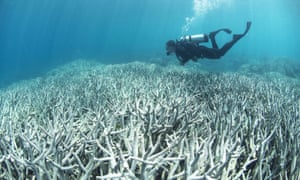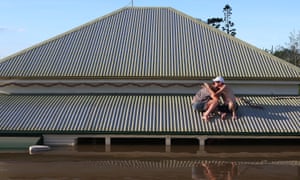NEWS.com.au - Charis Chang
 |
| Labor leader Bill Shorten visits the Great Barrier Reef which is under threat from climate change. Picture: Jason Edwards |
IF YOU are confused about what the major parties are doing about environment policy, you're not the only one.
The
subject has been bogged down in claims and counterclaims and no where
was this more apparent than during a leaders debate on Sunday, and one
held at the National Press Club earlier this month between the
environment ministers.
How do you make sense of it all? Here's our easy guide to understanding what's going on.
WHY EVERYONE CARES ABOUT THE 'TARGET'
Both
Labor and Liberal parties go on and on about meeting targets and this
is very important to them because it shows they are 'doing enough'.
The
main aim of the game is to limit global warming to "well below" two
degrees. It's a target that countries around the world committed to as
part of the Paris Agreement.
Just to be clear, climate change has
been identified as the biggest risk to future of the Great Barrier Reef,
something that Opposition Leader Bill Shorten
acknowledged today saying it supports 70,000 jobs and is worth $5.7 billion to the Australian economy.
Two
degrees of warming could still see global sea levels rise by as much as
half a metre by the end of the century compared to 1985-2005. It would
increase the intensity and frequency of bushfires, flooding and
droughts. So countries want to stay below it.
The difficulty is how to do this.
WHAT THEY'RE PROMISING
Both major parties committed to a previous target of between five to 25 per cent below 2000 levels by 2020.
But last month Labor revealed an ambitious new goal to cut emissions by 45 per cent by 2030, in line with what the
Climate Change Authority recommended to keep warming below two degrees.
The
Turnbull Government has also upped the ante, promising to reduce carbon
emissions by between 26 and 28 per cent by 2030, based on 2005 levels.
But this is well below the authority's recommendation of 45 per cent to
65 per cent.
So far the government believes it will achieve a five per cent reduction and meet its original goal.
But
whoever wins the election is going to have to really ramp up their
efforts if they have any chance of meeting their new targets.
 |
| Labor leader Bill Shorten visits the Great Barrier Reef. Picture: Jason Edwards Source: News Corp Australia |
HOW LABOR WILL MEET TARGETS
OK,
we all know what happened last time someone dared to bring in a carbon
tax (remember 'ditch the witch'?). Now only referred to in hushed
whispers, both parties want to stay well away from any suggestion they
could bring in a new tax.
Labor has been a bit braver, openly
putting their support behind an emissions trading scheme. This forces
companies to bid for permits that allow them to emit carbon emissions.
These permits can be traded, used or saved for the future. It also wants
Australia to get half of its electricity from renewable energy by 2030.
But details of exactly how its emissions trading scheme will operate after its first two years are vague.
In
contrast the Coalition has been careful to stay well away from any
suggestion the government's policy could even transition one day to a
trading scheme.
It wasn't always this way, former Liberal prime
minister John Howard promised to bring one in during the 2007 election.
He lost and the rest is history.
But you can't blame the leaders
for being a bit sensitive over the matter, PM Malcolm Turnbull lost the
Liberal leadership the first time round, over his support for Labor's
scheme, while Labor lost the election after it introduced a carbon tax.
TARGET TRICKERY
Australia
is one of a number of countries that also supports a 1.5 degree
(non-binding) target and this is where it has been accused of trickery.
It agreed to support the tougher target in exchange for other countries allowing it to widen the definition of "emissions".
Carbon
emissions from industrial and other sources have actually been
increasing but Australia has managed to meet its emissions reduction
targets partly because it's now allowed to include changes in land use.
 |
| Environment Minister Greg Hunt and representatives from the Coalition's Green Army. Picture: Steve Tanner Source: News Corp Australia |
The
rate of land clearing in Australia has declined since the 1990s and
this is now counted towards the country's emissions reduction target.
Lower electricity demand and the closure of heavy manufacturing has also helped.
SO GIVE IT TO ME STRAIGHT, WHAT IS 'DIRECT ACTION'?
Here's where it becomes complicated, but bear with me.
The government has said it will reduce emissions through its "Direct Action Scheme".
Some
people hate this scheme because it basically involves a huge pool of
money ($2.5 billion over four years to be exact) being handed to
polluters (mines, farmers etc) to encourage them to stop polluting.
It basically reverses the situation with the carbon tax, where polluters had to pay the government if they polluted.
But
Environment Minister Greg Hunt told the National Press Club recently
that the program was working. So far the government has purchased 143
million tonnes of carbon abatement using $1.7 billion. This prices
carbon at just over $12 per tonne.
In contrast Mr Hunt said Labor's policy would not actually reduce emissions in Australia.
"That
is the dirty secret at the heart of their policy ... They are
purchasing overseas," Mr Hunt said. However, he would not rule out doing
this as well, saying only that the government would do the "bulk of the
lifting in Australia".
But some don't think Australia can actually meet its emissions targets using the government's scheme.
Shadow
environment minister Mark Butler said Australia was pretty much the
only major advanced economy where pollution levels were going up.
Analysis of government data
has predicted pollution will rise by about six per cent between now and
2020, compared to dropping eight per cent while Labor was in office.
During
the leaders debate on Sunday, the Prime Minister said the government
expected to exceed its original target of reducing emissions by five per
cent, by nearly 80 million tonnes.
But in order to meet its new
2030 target the government will have to reduce emissions by a further
900 million tonnes between 2020 and 2030.
The Climate Institute
think tank has calculated that it could cost a whopping $16 billion to
$37 billion a year for Australia to reach its new 2030 target using
Direct Action, according to
The Guardian.
This is a huge jump from the $2.5 billion over four years that the fund has access to now.
I KEEP HEARING ABOUT A MYSTERIOUS 'SAFEGUARD MECHANISM'?
The
'safeguard mechanism' is due to start in July and has been described as
an emissions trading scheme by stealth, but you won't catch the
government admitting this.
The scheme will help the government to
achieve a five per cent cut in emissions by 2020, and puts a cap on how
much big polluters can omit. Mr Hunt has said it would cover 50 per cent
of emissions in Australia.
Critics of the government's policy say the safeguard mechanism isn't strict enough to prevent emissions increases.
 |
| On a wing and a prayer? Some say the government's environment policy won't meet emissions reduction targets. Picture: Tracey Nearmy Source: AAP |
"Eighty
per cent of the liable entities won't be impacted at all by the
safeguards mechanism," Mr Butler said, pointing to independent analysis
that showed it would not cap, let alone reduce emissions from the 20
largest polluters.
REALLY, THEY JUST NEED TO AGREE
While
both parties spruik the differences in their policies, there are
similarities and increasing calls for them to agree on a common path.
Mr
Butler acknowledged that there wasn't one democracy in the world that
had a serious climate change policy without some level of agreement
between major parties.
"There really is a challenge for the next parliament," he said.
"Otherwise, we'll be in the 2019 election ... again not having made progress in this area."
The
Environment Minister admitted the question of bipartisanship was
important while conceding it hadn't been sufficiently asked, nor
answered, on any side.
Mr Hunt said he thought agreement could be found in his government's safeguard mechanism.
But Mr Butler isn't sold on that idea, saying Labor did not believe in taxpayer money purchasing emissions abatement.
Another
sticking point is the emissions reduction target, with the government
sticking to its 26 to 28 per cent by 2030 goal, while Labor wants to
increase that to 45 per cent. It also wants to double the renewable
energy target.
Mr Turnbull said bipartisanship was always
desirable for long-term issues but Labor had not explained how much its
plan would cost.
"My commitment is to ensure that Australia meets the target we agreed to in Paris," he said.
"When the global community agrees to higher targets, as I have no doubt it will, that we will meet them, too.
"But
I believe we should move with the global community rather than taking
unilateral action that will not influence global action that may be
worthwhile from a political point of view."
 |
| Will Australia ever have a bipartisan agreement on climate policy? Picture: Tracey Nearmy Source: AP |






